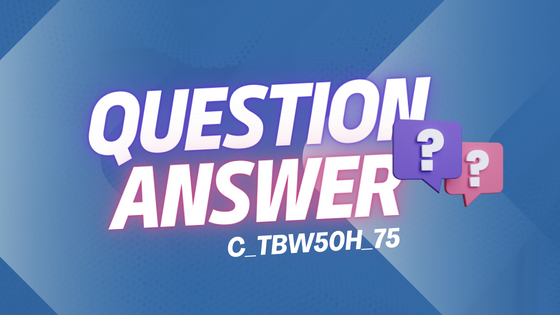11. Which of the following tools can be used to create BW queries?
Please choose the correct answer.
a) SAP BW Modeling Tools
b) SAP HANA Studio
c) BEx Query Designer
d) SAP Data Services
Answer: c
12. In a scenario where a business analyst wants to analyze sales data with drill-down capabilities based on time, region, and product, which of the following would be the most suitable component?
Please choose the correct answer.
a) Key Figure
b) InfoObject
c) Characteristic
d) Condition
Answer: c
13. Which of the following are functionalities provided by BW Query Designer?
Please select all the correct answers that apply.
a) Creating calculated key figures.
b) Defining filters and restrictions.
c) Data extraction from source systems.
d) Designing variable prompts for user input.
e) Loading data into DataStore Objects.
Answer: a, b, d
14. Which of the following techniques can be used to optimize the performance of a BW query?
Please choose the correct answer.
a) Increasing the data volume in the underlying InfoProvider
b) Using aggregates
c) Avoiding the use of indexes
d) Running multiple queries simultaneously
Answer: b
15. In a real-time scenario, a business analyst notices that a particular BW query is taking a long time to execute. Which of the following could be a potential reason for the slow performance?
Please choose the correct answer.
a) The query is retrieving a small data set.
b) The underlying InfoProvider has no aggregates defined.
c) The query is using optimized formulas.
d) The BW system has been recently upgraded.
Answer: b
16. Which of the following are best practices for optimizing BW query performance?
Please select all the correct answers that apply.
a) Minimizing the use of calculated key figures.
b) Using appropriate aggregates and indexes.
c) Avoiding the use of variables.
d) Limiting the data retrieved by using filters.
e) Regularly updating statistics of the underlying InfoProvider.
Answer: a, b, d, e
17. Which of the following is a key component of the Layered Scalable Architecture (LSA++) in SAP BW?
Please choose the correct answer.
a) Data Acquisition Layer
b) Data Presentation Layer
c) Data Extraction Layer
d) Data Transformation Layer
Answer: a
18. In a scenario where an organization wants to maintain a historical version of its data, which of the following would be the most suitable modeling object?
Please choose the correct answer.
a) InfoCube
b) DataStore Object (advanced) with data tiering
c) Composite Provider
d) Open ODS View
Answer: b
19. Which of the following are benefits of using the LSA++ architecture in SAP BW?
Please select all the correct answers that apply.
a) Simplified data modeling.
b) Real-time data replication.
c) Reduced data layers and data redundancy.
d) Enhanced data extraction capabilities.
e) Improved query performance.
Answer: a, c, e
20. What is the primary advantage of hybrid modeling in SAP BW powered by SAP HANA?
Please choose the correct answer.
a) Combining the strengths of both native HANA modeling and BW modeling.
b) Reducing the need for data extraction.
c) Eliminating the use of BW InfoProviders.
d) Simplifying the data transformation process.
Answer: a
21. In a real-time scenario, a company wants to leverage the capabilities of both SAP BW and native HANA for complex data modeling. Which approach would be most suitable?
Please choose the correct answer.
a) Purely BW modeling
b) Purely HANA modeling
c) Hybrid modeling
d) External HANA view modeling
Answer: c
22. Which of the following are true regarding hybrid modeling in SAP BW on HANA?
Please select all the correct answers that apply.
a) It allows the use of HANA Calculation Views in BW.
b) It requires data replication between BW and HANA.
c) It provides flexibility in choosing modeling techniques.
d) It eliminates the need for BW transformations.
e) It supports real-time data acquisition.
Answer: a, c, e

No comments:
Post a Comment